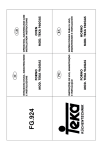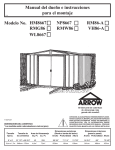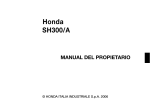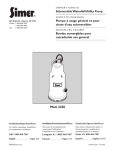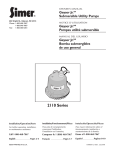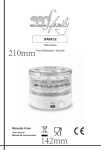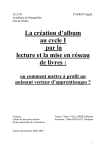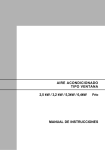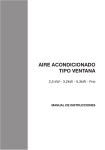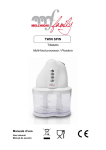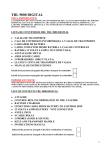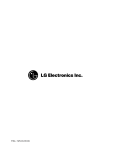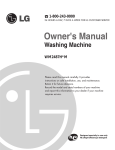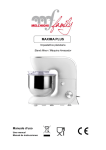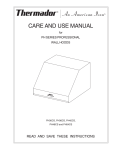Download Smart Automatic Battery Charger
Transcript
Pro 30 TM Smart Automatic Battery Charger OWNER’S MANUAL AND WARRANTY INFORMATION 12 VOLT 2/6/10 AMPERE CHARGE RATES WITH ALTERNATOR VOLTAGE CHECK FUNCTION • IMPORTANT SAFETY INSTRUCTIONS • WARNING – RISK OF EXPLOSIVE GASES 1.WORKING IN THE VICINITY OF A LEAD-ACID BATTERY IS DANGEROUS. BATTERIES GENERATE EXPLOSIVE GASES DURING NORMAL BATTERY OPERATION. FOR THIS REASON, IT IS OF UTMOST IMPORTANCE THAT EACH TIME BEFORE USING YOUR CHARGER, YOU READ THIS MANUAL AND FOLLOW THE INSTRUCTIONS EXACTLY. 2.To reduce risk of battery explosion, follow these instructions and those published by the battery manufacturer and manufacturer of any equipment you intend to use in vicinity of battery. Review cautionary markings on these products and on engine. GENERAL SAFETY 1.Use this charger for charging a 12 VOLT LEAD-ACID battery only. It is not intended to supply power to a low voltage electrical system other than in a starter-motor application. DO NOT use this battery charger for dry-cell batteries that are commonly used with home appliances. These batteries may burst and cause injury to persons and damage to property. 2. Use of an attachment not recommended or sold by the battery charger manufacturer may result in a risk of fire, electric shock or injury to persons. 3. To reduce risk of damage to electric plug and cord, pull by plug rather than cord when disconnecting charger. 4. An extension cord should not be used unless absolutely necessary. Use of an improper extension cord could result in a risk of fire and electric shock. If extension cord must be used, make sure: a. Pins on plug of extension cord are the same number, size and shape as those of plug on charger. b. Extension cord is properly wired and in good electrical condition; and c. Wire size is AWG#14 (14 gauge) to 100 feet and AWG#12 for distances over 100 ft. 5. Do not operate charger with damaged cord or plug – take to a qualified service technician for replacement of the cord or plug immediately. 6. Do not operate charger if it has received a sharp blow, been dropped, or otherwise damaged in any way; take it to a qualified service technician. SAVE THESE INSTRUCTIONS: This manual contains important safety and operating instructions for the Power Wizard FarmPro™ 30 Battery Charger. Call 800-866-2161 for customer service. 7. Do not disassemble charger; contact a qualified service technician when service or repair is required. Incorrect reassembly may result in risk of electric shock or fire. 8. To reduce risk of electric shock, unplug charger from outlet before attempting any maintenance or cleaning. Turning off charger controls will not reduce this risk. 9. Do not operate charger in rain or snow or use when wet. 10. Never charge a frozen battery. This device complies with part 15 of the FCC rules. Operation is subject to the following two conditions: (1) this device may not cause harmful interference, and (2) this device must accept any interference received, including interferene that may cause undesired operation. PERSONAL PRECAUTIONS AND SAFETY 1. Another person should be close enough to come to your aid when you work near a lead-acid battery. 2. Fresh water and soap should be nearby in case battery acid contacts skin, clothing or eyes. 3. Wear eye protection and protective clothing. Avoid touching eyes or skin while working with a battery. If acid particles or corrosion gets into eyes, immediately flood eye with cold water (Eye Wash Station) for at least 10 minutes and get medical attention immediately. 4. If battery acid contacts skin or clothing, wash immediately with soap and water. 5. NEVER smoke or allow a spark or flame in vicinity of battery or engine. 6. CAUTION: Dropping metal tool or other object onto battery may cause spark, short-circuit battery or other electrical components and may cause explosion. 7. Remove personal metal items such as rings, bracelets, necklaces and watches when working with a lead-acid battery. Lead-acid batteries can produce a short-circuit current high enough to cause a severe burn. POWER CORD CONNECTION This appliance has a polarized plug (one blade is wider than the other) as a safety feature. This plug will fit into a polarized outlet only one way. If the plug does not fit fully into the outlet, reverse the plug. If it still does not fit, contact a qualified electrician. Do not attempt to defeat this safety feature. PREPARING TO CHARGE 1. Determine voltage of battery by referring to car owner’s manual. 2. If necessary, remove battery from vehicle to charge, or to clean terminals, always remove grounded terminal from battery first. Make sure all accessories in the vehicle are off, so as not to cause an arc. 3. Clean battery terminals. Be careful to keep corrosion from coming in contact with eyes or skin. 4. Add distilled water in each cell until battery acid reaches manufacturer’s specified level. This helps purge excessive gas from cells. Do not overfill. For a battery without cell caps, carefully follow manufacturer’s recharging instructions. 5. Study all battery manufacturers’ precautions such as removing or not removing cell caps while charging and recommended charging rates. 6. Area around battery should be well-ventilated while battery is being charged. Gas can be forcefully blown away by using a piece of cardboard or other nonmetallic material such as a fan. 7. Make sure the initial charging rate does not exceed manufacturer’s recommendation. –2– CHARGER LOCATION 1. Locate charger as far away from battery as cables permit. 2. NEVER place charger directly above battery being charged; gases from battery will corrode and damage charger. 3. NEVER allow battery acid to drip on charger when reading specific gravity or filling battery cells with battery acid. 4. NEVER operate charger in a restricted or non-ventilated area. 5. Marine batteries must be removed and charged on shore. 6. Do not set a battery on top of charger. DC CONNECTION PRECAUTIONS 1. Connect and disconnect DC output clamps only after unplugging AC cord from outlet. 2. Never allow clamps to touch each other. 3. Attach clamps to battery posts and check for secure connection. This will hold clamps securely on terminals and helps to reduce risk of sparking. FOLLOW THESE STEPS WHEN BATTERY IS INSTALLED IN VEHICLE. A SPARK NEAR BATTERY MAY CAUSE BATTERY EXPLOSION. TO REDUCE RISK OF A SPARK NEAR BATTERY: 1. Position AC and DC cords/cables to reduce risk of damage by hood, door, or other moving engine parts. 2. Stay clear of fan blades, belts, pulleys and other parts that can cause injury. 3. Check polarity of battery posts. POSITIVE (POS, P, +) battery post usually has larger diameter than NEGATIVE (NEG, N, –) post. 4. Determine which battery post is grounded (connected) to the chassis. If negative post is grounded to chassis (as in most vehicles), see (e). If positive post is grounded to the chassis, see (f). 5. For negative-grounded vehicle, connect POSITIVE (RED) clamp from battery charger to POSITIVE (POS, P, +) post of battery. Connect NEGATIVE (BLACK) clamp to vehicle chassis or engine block away from battery. Do not connect clamp to carburetor, fuel lines, or sheet-metal body parts. Connect to heavy gauge metal part of the frame or engine block. 6. For positive-grounded vehicle, connect NEGATIVE (BLACK) clip from battery charger to NEGATIVE (NEG, N, –) post of battery. Connect POSITIVE (RED) clamp to vehicle chassis or engine block away from battery. Do not connect clamp to carburetor, fuel lines, or sheet-metal body parts. Connect to a heavy gauge metal part of the frame or engine block. 7. When disconnecting charger, disconnect AC cord first. Then remove clamps from vehicle chassis from battery terminal. 8. Refer to operating instructions for length of charge information. 9. Do not charge the battery while the engine is operating. FOLLOW THESE STEPS WHEN BATTERY IS INSTALLED OUTSIDE OF VEHICLE. A SPARK NEAR THE BATTERY MAY CAUSE BATTERY EXPLOSION. TO REDUCE THE RISK OF A SPARK NEAR BATTERY: 1. Check polarity of battery posts for top-mounted battery connectors, the POSITIVE posts (marked POS, P, +) usually has a larger diameter than the NEGATIVE battery post (marked NEG, N, –). For side-mounted battery connections, the POSITIVE terminal is RED, the NEGATIVE terminal is black. 2. Attach a 24-inch (minimum length) 6 AWG insulated battery cable to the NEGATIVE battery post (marked NEG, N, –). 3. Connect the POSITIVE (RED) battery clamp to the POSITIVE battery connector (marked POS, P, + or RED). –3– 4. Stand as far back from the battery as possible, and do not face battery when making final connection. 5. Carefully connect the NEGATIVE (BLACK) charger clamp to the free end of the battery cable connected to the negative terminal. 6. Set the charge rate to appropriate setting according to battery size. 7. When disconnecting charger, always do so in reverse sequence of connecting procedure and break first connection while as far away from battery as practical. 8. A marine (boat) battery must be removed and charged on shore. To charge it on board requires equipment specially designed for marine use. NOTE: This equipment has been tested and found to comply with the limits for a Class B digital device, pursuant to Part 15 of the FCC rules. These limits are designed to provide reasonable protection against harmful interference in a residential installation. This equipment generates, uses and can radiate radio frequency energy and, if not installed and used in accordance with the instructions, may cause harmful interference to radio communications. However, there is no guarantee that interference will not occur in a particular installation. If equipment does cause harmful interference to radio or television reception, which can be determined by turning the equipment off and on, the user is encouraged to try to correct the interference by one or more of the following measures: • Reorient or relocate the receiving antenna. • Increase the separation between equipment and receiver. • Connect the equipment to an outlet on a circuit different from that to which the receiver is connected. • Consult the dealer or an experienced radio/TV technician for help. INTRODUCTION Thank you for selecting the Power Wizard FarmPro™ 30 – 2/6/10 Amp 12 Volt Smart Battery Charger with Alternator Voltage Check and Battery Voltage Check functions. With proper care and use, it will give you years of dependable service. This battery charger has a high charge rate of up to 10 amps, and low charge rate of up to 2 amps. It is designed for charging only 12 volt lead-acid batteries – conventional automotive, maintenance-free, marine deep cycle and gel – used in cars, trucks, farm equipment, boats, RVs and SUVs, lawn mowers/garden tractors, motorcycles, personal watercraft, snowmobiles, ATVs and various commercial applications. Power Wizard FarmPro™ 30 Smart Battery Chargers feature 3-stage, high-efficiency charging technology, built-in microprocessor control that ensures fast, safe and complete charge on serviceable batteries (see FIGURE 2). Stage One – Rapid Start Charge delivers maximum charging amperage to “wake up” any serviceable 12 volt battery and allows for quick engine starting in just 5 minutes (based on a midsize vehicle battery at 50% charge level). When battery reaches a maximum safe predetermined voltage, the charger will automatically signal a “beep” and move into Stage 2 of the charging process. At the end of Stage 2, the charger will signal a BEEP and move into Stage 3 charge mode. Stage Two – Absorption Charge maintains the maximum possible charge at a constant, safe, predetermined voltage. During the phase, voltage absorption regulation charge, the charging voltage remains constant, while the actual charging current is reduced to allow for the maximum proper internal chemical energy transfer. Stage Three – Top-Off Charge voltage is automatically maintained and reduced to a predetermined level while current is adjusted for a safe, effective battery charge level (stepdown regulation mode); ideal for topping off batteries that have been in storage. At the conclusion of Stage 3, the unit will BEEP signaling the completion of the charging cycle. The Automatic Float Charge feature is ideal for maintaining a battery. It automatically tops off a battery as needed, to keep it fully charged all the time. –4– Figure 2. Charge Curve STAGE ONE BEEP BEEP STAGE TWO STAGE THREE OFF BEEP CHARGING COMPLETE FEATURES • • • • • • • • • • • • • This unit has three charge rate settings, with a 2/6/10 amp push button charge rate switch: a)2 amps: smaller batteries, as in lawn mowers, snowmobiles, motorcycles, etc. b)6 amps: middle-sized batteries, such as in small cars c) 10 amps: automobile batteries and light trucks Automatic float charge monitoring Microprocessor controlled for proper operation and for fault detection Large lighted digital display, shows charging current and codes that indicate faults and modes of operation and timeout of functions High frequency, switch-mode operation for pure DC output Rapid charging three stage output Heavy-duty cables and clamps are corrosion-resistant Connect to side or top-mount battery terminals Rugged case with baked-on finish, plus sturdy carrying handle Self storage of cables and clamps Ideal during winter season when vehicle’s starting performance is reduced by cold or extreme weather conditions Single beep tone indicates a button is pressed or a mode change occurs Alternator Voltage Check can determine if the alternator output is within a typical voltage range. Figure 3A. Front View WARNINGS: THERE ARE NO USER-SERVICEABLE PARTS IN THIS CHARGER. DO NOT OPEN THE UNIT! IT MUST BE RETURNED TO POWER WIZARD FOR PROFESSIONAL TESTING AND REPAIR. OPENING THE UNIT WILL VOID THE MANUFACTURER’S WARRANTY. Contact Power Wizard at (800) 866-2161. Contact Power Wizard at (800) 866-2161 toll-free for further information. –5– Figure 4A. Control Panel Figure 4B. Control Panel CONTROLS AND INDICATORS From right to left the function buttons are: ALTERNATOR Five second Good/Bad output check. Checks for low and high CHECK output. High output can “cook” and destroy a battery. Low output never fully charges the battery. (FIGURE 4A). 2/6/10 AMP Allows the user to select the charger rate based on battery size. This selection and actual battery charge rate are monitored by the microprocessor and will stop charging if the rate is too fast or too slow for battery size or condition. OFF This prepares the charger to be placed in any of the operating modes. Pressing the OFF button immediately stops any operating mode and the display shows the circulating pattern (FIGURE 4B). BATTERY VOLTAGE Enables a check that measures the battery voltage and displays it for 3 seconds. INDICATORS Large (.375”) 3-character digital display in the upper left of the control panel indicates many conditions and/or status codes: When AC power is applied to the charger, actual charge rate in amps, when the battery is fully charged, fault codes, operating modes and when the charger is ready for the next mode selection. “Status Codes” are described below (FIGURE 5) and on the back of charger. Figure 5. AC POWER INDICATOR – When connected to an AC outlet, digital display shows circulating pattern to indicate power is on. FAULT CODES F01 INTERNAL SHORTED CELL BATTERY – Cannot be charged, bad battery. Replace battery. EXCESSIVE LOAD ON BATTERY WHILE CHARGING – Check load. F02 BAD BATTERY CONNECTION – Check battery connection. BATTERY VOLTAGE TOO LOW TO ACCEPT CHARGE – Bad battery. Replace battery. F03 INTERNAL OPEN CELL – Bad battery. Battery needs to be replaced. SULFATED CONDITION – Battery needs to be reconditioned or replaced. See manual. F04 OVERTIME CONDITION – Battery will not accept a charge after 18 hours of continuoous charging. Battery has internal dam- age and needs to be replaced or BATTERY CHARGE RATE IS SET TOO LOW. Set charger to higher charge rate. See manual. F05 OVERHEATED CONDITION – Disconnect charger and allow to cool for 30 min., check for ample ventilation. OPERATION CODES – – – ALTERNATOR VOLTAGE CHECK 000 CHARGER STANDBY FUL BATTERY FULLY CHARGED FLO FLOAT CHARGE –6– Below the digital display are a series of four LEDs that light on the following conditions: FAULT Lights when any of several faults are detected – see F01 through F05 codes as described above (if the Fault LED lights, refer to TROUBLESHOOTING for details) REV. Lights when clamps are incorrectly connected to battery POLARITY terminals. CHARGING Indicates battery is charged. Charging Complete LED lights at COMPLETE same time the digital display shows “FUL”. ALTERNATOR Lights when load or not load checks show the alternator is GOOD keeping up with the electrical load. CHARGE RATE SELECTION After charger clamps are correctly connected, plug in the charger to an AC outlet and the charger will show a circulating pattern on the digital display. This pattern indicates power is applied. Select proper charge current rate based on battery size. Press the 2/6/10 amp push button and the charger will begin charging at 2 amps. Pressing the 2/6/10 amp push button again will advance the charge rate to 6A, then 10A. Pressing the switch again will turn OFF the charger output and the display will show “000”. NOTE: The only time the selected charge rate does not display at the full selected rate is when the battery is nearly full and charging at either step two or three. The display will be showing a slowing charge rate. To return to 2A, press the 2/6/10 amp button. When the battery is fully charged, the Charging Complete LED is lit and “FUL” is displayed on the digital display. CHARGING THE BATTERY 1. Charger displays circulating pattern when battery and AC power are connected properly. Press 2/6/10 amp button to begin charging at 2 amps rate; the charger sounds a beep and displays charging current. WARNING: If charger displays F02, and lights FAULT indicator, the connection to battery terminals is bad. Clean battery terminals, then reconnect clamps. If Rev Polarity indicator also lights, the RED (POSITIVE) and BLACK (NEGATIVE) clamps are incorrectly connected to battery terminals. Reverse the clamps. NOTE: •The charger starts charging at 2 amps rate automatically if 2/6/10 amp button is not pressed within 3 minutes after applying AC power. •Charger occasionally sounds a beep and displays 0.0 during self-test or charging stage changes. 2. Pressing the 2/6/10 amp button again advances charging rate to 6 amps and pressing once more advances charging rate to 10 amps. NOTE: •If the battery is near full, it will fall back to lower charge rate. •Pressing the 2/6/10 amp 4 times advances to standby mode; sounds a beep, displays 000 and stops charging. 3. The battery charger displays the charge current. To view the battery voltage, press BATTERY VOLTAGE button. The charger will sound a beep and display the battery voltage for 3 seconds, then returns to display charge current. 4. The display shows FUL and Charging Complete LED lights when the battery is fully charged. 5. Disconnect the AC power cord first, then the NEGATIVE clamp and finally the POSITIVE clamp. –7– Automatic Float Charging – Ideal for Maintaining a Fully Charged Battery 1. Keep the AC power and battery connected after battery is fully charged. 2. The charger monitors the battery and tops it off as needed. 3. The display shows FLO in topping off the battery and returns to FUL when completed. 4. To view battery voltage, press BATTERY VOLTAGE button. NOTE: • Charging can be terminated by pressing OFF button at any time. • After AC power interruption, charging restarts at 2 amps rate automatically. ALTERNATOR VOLTAGE CHECK PART 1: No Load (Turn OFF all vehicle’s accessories): The battery must be fully charged before testing the alternator. Run the engine long enough to achieve normal idle speed and verify there is a no-load voltage. 1. PRESS Alternator Check to start the check. 2. ALTERNATOR GOOD LED will light to indicate the alternator is good, or the FAULT LED will light to indicate the alternator is not good. 3. Press Alternator Check button again to stop the test. PART 2: Under Load (Accessories ON): Next, load the alternator by turning on as many accessories as possible (except for A/C and DEFROST) 1. PRESS Alternator Check to start the check. 2. ALTERNATOR GOOD LED will light to indicate the alternator is good, or the FAULT LED will light to indicate the alternator is not good. 3. Press Alternator Check button again to stop the test. If the first alternator check indicates a good alternator and the second indicates the alternator is bad, the problem could stem from: loose fan belts, an intermittent diode failure or possibly bad connections between the battery and alternator and/or ground. NOTE: BATTERY VOLTAGE button is disabled in Alternator Check mode. NOTE: It may be that someone has added a number of accessory loads on the charging system, thereby increasing current demand from the alternator. MAKE SURE THAT THE ALTERNATOR IS RATED TO THE APPLICATION. NOTE: This check may not be accurate for every make, manufacturer and model of vehicle. There is wide variation in user-controlled electrical loads, alternator output and wiring. Other factors include battery condition, temperature and engine idle speed. It is recommended to check your alternator when it is known to be operating properly to verify that this check is valid for your particular vehicle. Check only 12V systems. Checking 24 or 36V systems will damage charger. NOTE: Do not charge the battery while waiting for the engine to warm. This will invalidate any alternator check. The digital display should show the circulating pattern while the engine is warming. Do not turn on A/C or the defroster system to load the alternator. These accessories may start operating during a test sequence and give an invalid result. GENERAL BATTERY SAFETY With minimal maintenance, the Power Wizard FarmPro™ 30 2/6/10 AMP Smart Battery Charger will provide years of dependable service. Follow these simple steps to maintain the charger in optimum condition: • After each use, clean the battery charger clamps – be sure to remove any battery fluid that will cause corrosion of the copper clamps. –8– • Clean the outside case of the charger with a soft cloth and, if necessary, mild soap solution. • Do not allow liquid to enter the charger. Do not operate when charger is wet. • Do not use charger if cords or clamps have been damaged in any way – call Power Wizard toll-free: (800) 866-2161 to replace cords and clamps. TROUBLESHOOTING – FAULT LED LIT The following conditions may light the FAULT LED: • Poor connection to battery (or frame). • Charging too fast – decrease charge rate – press 2/6/10 amp button to lower rate. • Charging too slowly – battery is large and did not complete charging in 24 hours – press 2/6/10 amp to charge at a faster rate. • Shorted battery cell – replace battery (F01). • Open battery cell – replace battery (F03). • Reverse Polarity LED Lit – disconnect AC then reverse clamp locations on battery and frame. • Internal overheat in charger – make sure fan is not blocked (F05). Try charging another battery, if the FAULT LED does not light, then one of the above problems exists with the initial battery. Charger will not charge and the fan will not operate if there is a fault. Call Power Wizard toll free: 800-866-2161. INTERNAL SHORT CELL BATTERY (F01) • If the battery being charged has an internal shorted cell, the FAULT LED will light. • If FAULT LED light comes on, Power Wizard recommends you take your battery to a certified automotive service center for evaluation. BATTERY NOT ACCEPTING A CHARGE • Make sure that the charger is plugged into a “live” 110/120VAC outlet and power LED is lit. • Unplug charger and check battery connections – ensure that there is a good connection at the battery terminal and/or vehicle chassis. • Check that the correct charge rate was selected for the battery being charged. • Ensure that enough charging time was allowed for – check table on this page for approximate charging times. NOTE: Charger will NOT operate on batteries below 2.0 volts. If a 12 volt battery is below 2.0 volts, it is probably shorted, open or sulfated and should be replaced. VERY COLD BATTERY If the battery to be charged is extremely cold (in temperatures less than freezing – 0˚C / 32˚F) it cannot accept a high rate of charge, so the initial charge rate will be slow. The rate of charge will increase as the battery warms. WARNING: DO NOT ATTEMPT TO CHARGE A FROZEN BATTERY CHARGING TIMES The Power Wizard FarmPro™ 30, a fully automatic Smart Battery Charger, will automatically adjust the charge rate as the battery becomes charged and stops charging when the battery is fully charged. For estimates of the time it takes to charge a battery, refer to the following table for details. Deep cycle batteries may need longer charging times. It is recommended to repeat the charging cycle a second time, beginning with the 2 AMP rate. The following chart converts hydrometer readings into percent of charge values. Refer to the chart on the next page for approximate charging times. –9– SPECIFIC GRAVITY (HYDROMETER READING) 1.265 1.225 1.190 1.155 1.120 PERCENT OF CHARGE IN BATTERY 100% 75% 50% 25% 0% PERCENT OF CHARGE NEEDED BY BATTERY 0% 25% 50% 75% 100% The times shown in the chart above are approximate and refer to an average automotive battery. For smaller batteries, the charge time should be adjusted using the formula shown below and adding 1 hour to the time calculated. To estimate charging time for a discharged battery, divide the amp hour (aH) rating of the battery by the charge rate selected. This is the number of hours required to recharge the battery. For example, a 50 aH (12 volt) battery is discharged (10 volts). How long should it be charged at the 10 amp rate? Divide the 50 aH by 10. Answer: 5.5 hours. Always round up the charge time by 10% to ensure full charge. In most cases, battery charging times will vary depending on the age and condition of the battery. Smaller batteries should be charged at a lower rate (2 amps) and add an extra hour to charge time. PERCENT OF CHARGE 2 AMPS 6 AMPS 10 AMPS 75% 7 HRS 2.5 HRS 1.4 HRS 50% 14 HRS 5 HRS 2.8 HRS 25% NR* 7 HRS 4.1 HRS 0% NR* 9.2 HRS 5.5 HRS *Not recommended POWER WIZARD, INC. / FARMPRO WARRANTY 30 DAY SATISFACTION GUARANTEE FARMPRO guarantees your complete satisfaction with this battery charger. If you are not satisfied with this product, you may return the battery charger to the original place of purchase within 30 days of purchase for a full refund. Proof of purchase is required for a full refund. LIMITED WARRANTY AgraTronix warrants this battery charger to the original purchaser for a period of two (2) years from the date of purchase, when installed and used in accordance with the enclosed installation instructions. You must retain your receipt for proof of purchase. This warranty covers defects in materials and workmanship to the battery charger. TERMS THAT APPLY TO BOTH THE GUARANTEE AND WARRANTY Improper installation, misuse, neglect and tampering of any kind are NOT covered under the 30-Day Guarantee or the Limited Warranty. No warranty other than the above is expressed or implied. Implied warranties of merchantability and fitness for a particular application are hereby disclaimed unless the law specifically precludes this disclaimer. The manufacturer and seller shall have no liability for damages, incidental or consequential, resulting from or caused by any failure, malfunction or defect of any product. The sole obligation of AgraTronix shall be limited to repair or replacement, at its option, of the defective battery charger or part and prepaid return to the owner. TO MAKE A WARRANTY CLAIM 1. First disconnect the battery charger from power source. 2. Attach a note with your name, return address, phone number and brief description of the problem. 3. Pack product carefully in oversized carton with crushed newspaper for cushioning. 4. Your product should be shipped prepaid and insured against shipping loss or damage. 5. Before returning product under warranty, you must call Power Wizard, Inc./FarmPro at (800) 8662161 to obtain a Return Goods Authorization number and a shipping address for the service center that will process the return. The RGA number must accompany the returned product. POWER WIZARD, INC. • FARMPRO 10375 State Route 43, Streetsboro, OH 44241 USA 800-866-2161 • 330-562-2222 http://www.agratronix.com Pro 30 TM Cargador de Baterìas Ràpido y Automàtico MANUAL DEL PROPIETARIO E INFORMACIÒN DE GARANTÌA 12 VOLTIOS 2/6/10 AMPERIOS INDICE DE CARGA CON ALTERNADOR DE VOLTAJE Y FUNCIÒN DE REVISIÒN • INSTRUCCIONES IMPORTANTES DE SEGURIDAD • ADVERTENCIA – RIESGO DE GASES EXPLOSÌVOS 1. TRABAJAR CON BATERÌAS DE PLOMO-ACIDO ES PELIGROSO. DURANTE EL FUNCIONAMIENTO NORMAL LAS BATERÌAS GENERAN GASES EXPLOSÌVOS. POR ESTA RAZÒN, ES DE SUMA IMPORTANCIA QUE CADA VEZ ÀNTES DE USAR SU CARGADOR, LEAS ESTE MANUAL Y SIGAS EXACTAMENTE LAS INSTRUCCIONES. 2. Para reducir el riesgo de una explosiòn de la baterìa, siga esta instrucciones y aquellos publicados por el fabricante de la baterìa y fabricante de cualquier equipo que vaya a usar junto a la baterìa. Revìse cautelosamente marcas de estos productos y en el motor. SEGURIDAD GENERAL 1. Use este cargador para cargar solo baterìas de 12 VOLT PLOMO-ACIDO. Se intenta proveer de energìa a un sistema elèctrico de baja tensiòn que a un arranque de motor. NO use este cargador de baterìa para baterias con celda-seca que se usan con electrodomèsticos. Estas baterìas pueden explotar y causar lesiones a las personas y daños a la propiedad. 2. El uso de un accesorio no recomendado o vendido por el fabricante del cargador de baterìa puede derivar en un riesgo de incendio, descarga eléctrica o lesiones a las personas. 3. Para reducir el riesgo de daño al enchufe eléctrico y al cordón, jale el enchufe del cordón cuando desconecte el cargador. 4. No debe usarse cable de extension a menos que sea necesario. El uso inadecuado de un cable de extensiòn puede derivar en un riesgo de incendio y descarga elèctrica. Si va a usar el cable de extensiòn, asegùrese que: a. Los pernos del enchufe del cable de extensiòn son del mismo nùmero, tamaño y forma que los del enchufe del cargador. b. El cable de extension esta debidamente conectado y en buen estado elèctrico; y c. El tamaño del cable es AWG#14 (14 calibre) a 100 pies y AWG#12 para distancias sobre 100 pies. 5. No prenda el cargador con cable o enchufe dañado – tome un servicio tècnico calificado para cambiar de inmediato el cable o el enchufe. 6. No haga funcionar el cargador si ha recibido un golpe fuerte, ha caìdo o de cualquier manera ha sido dañado llèvelo a un servicio tècnico calificado. 7. No desarme el cargador, contacte un servicio tècnico calificado cuando requiera una reparaciòn. Su rearmado inadecuado puede derivar en un incendio, descarga o fuego. GUARDE ESTA INSTRUCCIONES: Este manual contiene instrucciones importantes de funcionamiento y seguridad para el Power Wizard FarmPro™ 30 Cargador de Baterìa. Llame al 800-866-2161 para servicio de atenciòn al cliente 8. Para reducer el riesgo de una descarga elèctrica, desenchufe el cargador de la salida àntes de intentar un mantenimiento o limpieza. Apagar los controles no reduciran este riesgo. 9. No funcione el cargador en lluvia o nieve o cuando el tiempo este hùmedo. 10. Nùnca cargue una baterìa congelada Este dispositivo cumple con las normas 15 del FCC. Su funcionamiento esta sujeto a dos condiciones: (1) Este dispositivo no puede causar interferencias perjudiciales, y (2) Este dispositivo debe aceptar cualquier interferencia recibida, incluyendo interferencias que pueden causar operaciones no deseadas. PERSONAL DE SEGURIDAD Y PRECAUCIONES 1. Otra persona deberia estar lo suficientemente cerca para venire a ayudar cuando se trabaja cerca de una baterìa Plomo-Àcido. 2. Agua fresca y jabòn se debe tener cerca en caso de contacto de piel con la baterìa, vestimenta o los ojos. 3. Use protector para los ojos y la ropa. Evite tocarse los ojos o la piel mientras trabaja con una baterìa. Si partìculas àcidas o corrosiòn entra en sus ojos, llene sus ojos con agua fria de inmediato (lave el ojo). Por al mènos 10 minutos y consiga atenciòn mèdica de inmediato. 4. Si el àcido de la baterìa toca su piel o ropa, lave de inmediato con agua y jabòn. 5. NÙNCA fume o permita chispas en las cercanìas de la baterìa o del motor. 6. ADVERTENCIA: Dejar herramientas metàlicas u otros objetos tirados en la baterìa puede causar chispas, corto circuìto u otros componentes que pueden causar una explosiòn. 7. Quìte artìculos metàlicos como ser: anillos, pulseras, collares y relojes cuando trabaje con una baterìa de Plomo-Acido. Baterìas de Plomo-Acido pueden producir cortocircuìto de alta tensiòn que pueden causar incendios. CABLE DE CONEXIÒN Este aparato tiene un enchufe polarizado (una hoja es más ancha que la otra), como una medida de seguridad. Este enchufe encajará en un tomacorriente polarizado de salida en una sola dirección. Si el enchufe no encaja plenamente en el toma corrientes, invierta el enchufe. Si aùn no encaja,contàcte un elèctricista calificado. No intente vencer esta caracterìstica de seguridad. PREPARANDO LA CARGA 1. Determine el voltaje de la baterìa, hacienda referencia al manual del propietario del vehìculo. 2. De ser necesario, retire del vehìculo la baterìa para cargar, o para limpiar los terminales, siempre quìte primero el Terminal a tierra de la baterìa. Asegùrese que todos los accesorios del vehìculo estan apagados, a fin de no causar un arco. 3. Limpie los terminals de la baterìa. Tenga cuidado de que la corrosion no entre en contacto con los ojos o la piel. 4. Añadir agua destilada en cada celda hasta que el agua llegue al nivel especificado por el fabricante. Esto ayuda a depurar el gas excedente de la celda. No rebalse. Para una baterìa sin tapa en la celda, cuidadosamente siga las instrucciones de recarga del fabricante. 5. Estudie todas las precauciones del fabricante de la bateria como quitar o no las tapas de las celdassmientras esta cargando y recomendar ìndices de carga. 6. La baterìa debe encontrarse aireada mientras esta cargando. El gas puede ser extraìdo mediante una pieza de cartòn u otros materiales no metàlicos como un ventilador. 7. Asegùrese que el nivel de carga inicial no exceed las recomendaciones del fabricante. UBICACIÒN DEL CARGADOR 1. Coloque el cargador tan lejos como los cables lo permitan. 2. NÙNCA coloque el cargador sobre la baterìa que esta siendo cargada; gases de la baterìa corroeran y dañaran el cargador. – 12 – 3. NÙNCA permita que el àcido de la bateria gotèe sobre el cargador cuando lee específicamente el peso o llenado de la celda con el àcido de la baterìa. 4. NÙNCA maneje el cargador en un area no ventilada. 5. Baterìas marinas deben ser retiradas y cargadas en tierra. 6. No acomode una baterìa sobre un cargador DC PRECAUCIONES DE CONEXIÒN 1. Conectar y desconectar DC salidas de abrazaderas solo después de enchufar cable AC de salida. 2. Nùnca permita que las abrazaderas se toquen entre sì. 3. Adjùnte abrazaderas a la baterìa y revise para una conexiòn segura. Esto mantendra las abrazaderas seguras en los terminales y reducirà el riesgo de chispas. SIGA ESTOS PASOS CUANDO LA BATERÌA ESTE INSTALADA EN EL VEHÌCULO. UNA CHISPA CERCA PUEDE CAUSAR UNA EXPLOSIÒN. PARA REDUCIR EL RIESGO DE UNA CHISPA CERCA A LA BATERÌA: 1. Posiciòn AC y DC cuerdas/cables para reducer el riesgo de daños por el capò, puertas, u otras piezas móviles del motor. 2. Mantenerse alejado de las palas del ventilador, correas, poleas y otras partes que pueden causar lesiòn. 3. Verifique la polaridad de la baterìa. POSITIVO (POS, P, +) usualmente tiene un diámetro màs grande que el polo NEGATIVE (NEG, N, –). 4. Determine cuàl polo de la baterìa esta (conectado) a tierra por el chassis. Si el polo negativo esta conectado a tierra por el chasis (como en la mayoria de los vehìculos), ver (e). si el polo positivo esta conectado a tierra por el chasis, ver (f). 5. Para vehìculos tierra-negativo, conecte POSITIVO (ROJO) la abrazadera del cargador de baterìa al polo POSITIVO (POS, P, +) de la baterìa. Conecte NEGATIVO (NEGRO) la abrazadera al chasis del vehìculo o motor lejos de la baterìa. No conecte la abrazadera al carburador, paso de gasolina, hoja metàlica o partes del cuerpo. Conectar a metales pesados parte de la estructura o bloque del motor. 6. Para vehìculos tierra-positivo, conecte el clip NEGATIVO (NEGRO) del cargador de baterìa al polo NEGATIVO (NEG, N, -) DE LA BATERÌA. Conecte la abrazadera POSITIVA (ROJO), al chasis del vehìculo o bloque del motor lejos de la baterìa. No conecte las grampas al carburador, paso de gasolina, hoja metàlica o partes del cuerpo. Conectar a metales pesados parte de la estructura o bloque del motor 7. Cuando desconecte el cargador, desconecte el cable AC primero, quìte las abrazaderas del chasis del vehìculo a la Terminal de la baterìa 8. Consulte el manual de instrucciones para la duración de la carga de información 9. No cargue la baterìa mientras el motor esta funcionando. SIGA ESTOS PASOS CUANDO LA BATERÌA ESTE INSTALADA EN EL VEHÌCULO. UNA CHISPA CERCA PUEDE CAUSAR UNA EXPLOSIÒN. PARA REDUCIR EL RIESGO DE UNA CHISPA CERCA A LA BATERÌA: 1. Compruebe la polaridad de la baterìa para los conectores montados, el polo POSITIVO (marcadoPOS, P, +) usualmente tiene un diámetro màs grande que el polo NEGATIVO (macado NEG, N, –). Para la aconexiòn del lado armado de la baterìa el Terminal POSITIVO es ROJO, y el Terminal NEGATIVO es negro. 2. Adjunte a 24 pulgadas (longitud mínima) 6 AWG cable de batería con aislamiento al polo negativo de la batería (marcado NEG, N, -). 3. Conecte la abrazadera POSITIVA (ROJA) al conector de baterìa (marcado POS, P, + o ROJO). 4. Alejesè de la baterìa, no de la cara a la baterìa cuando realìze la conexión final. 5. Cuidadosamente conecte la abrazadera del cargador NEGATIVO (NEGRO) al extremo del cable de baterìa conectado al terminal negativo. 6. Establezca el nivel adecuado de carga segùn el tamaño de la baterìa. 7. Al desconectar el cargador, siempre hacerlo en secuencia inversa del procedimiento de conexión y romper primero la conexión mientras se aleja de la baterìa. 8. Una baterìa marina (bote) debe quitarse y cargarla en tierra. Cargarla a bordo require de equipos especiales diseñados para uso marino. – 13 – NOTA: Este equipo ha sido probado y cumple con los lìmites para un dispositivo digital de clase B, de conformidad con la parte 15 de la norma FCC. Estos lìmites estan diseñados para proporcionar una protecciòn rasonable contra intereferencias en una instalaciòn residencial. Este equipo genera, usa y puede irradiar energìa y si no se instala y utiliza de acuerdo a las instrucciones puede causar interferencias perjudiciales para la comunicación por radio. Sin embargo, no hay garantía de que no ocurran interferencias en una instalación en particular. Si el equipo causa interferencia perjudicial a la recepción de radio o televisión, lo cual puede determinarse apagándolo y encendiéndolo, se recomienda al usuario tratar de corregir la interferencia por una o varias de las siguientes medidas: • Reoriente o relocalìze el receptor de la antena. • Incremente la separaciòn entre el equipo y el receptor. • Conectar el equipo a una salida o circuìto diferente del que el receptor esta conectado. • Consulte a su distribuidor o a un tècnico especializado de radio/TV. INTRODUCCIÓN Y CARACTERÍSTICAS Gracias por seleccionar el Power Wizard FarmPro™ 30 – 2/6/10 Amp 12 Volt Smart Battery Charger con revisor de alternador de voltaje y funciones de revisiòn del voltaje de la baterìa. Con uso y cuidado apropiado, tendràs años de servicio útil. Este cargador de baterìa un nivel alto de carga hasta 10 amperios, y un nivel bajo de carga hasta 2 amperios. Esta diseñado para cargar solo baterias de 12 voltios Plomo-Acido de autos convencionales, libre mantenimiento, ciclo marino profundo y gel usado en carros, camiones, equipos agrícolas, botes, boogies, cortadoras de césped, tractores de jardìn, motos, motos acuàticas, motos de nieve y varias aplicaciones comerciales. Power Wizard FarmPro™ 30 Smart Battery Chargers Característica de 3 etapas, de alta eficiencia de tecnología de carga, una función de control por microprocesador que garantiza rápidas, seguras y completas cargas de baterías ùtiles (véase la figura 2). Fase Uno – Carga Ràpida Entrega una carga de amperaje màximo de 12 voltios para “despertar” cualquier servicio y permite un arranque ràpido de motor en solo 5 minutos (basados en baterias de vehìculo mediano al 50% de nivel de carga). Cuando la baterìa alcanza un màximo voltaje predeterminado de seguridad, el cargador indicarà automáticamente un “pitido” y la moverà a la segunda etapa del proceso de carga. Al finalizar la fase dos, el cargador indicarà con un PITIDO y lo moverà al modo de carga de la fase 3. Fase Dos – Carga de Absorción Mantiene la máxima carga en una constante, seguro, predeterminado voltaje. Durante la fase de absorción de regulación de carga del voltaje, la tensión de carga permanece constante, mientras que la corriente de carga se reduce para permitir la máxima y adecuada transferencia interna de energía química. Fase Tres Carga – Màxima de voltaje es automáticamente mantenida y reducida para pre determinar el nivel de corriente mientras se ajusta y asegura un fectivo nivel de carga de la baterìa (reducir el modo de regulación); Ideal para el relleno de baterías que han estado almacenadas. A la conclusión de la fase 3, la unidad de señalarà con un PITIDO que se completò el ciclo de carga. La caracterìstica del flotador automàtico de carga es que es ideal para mantener una baterìa, como la baterìa necesita una carga ràpida automáticamente la mantiene con carga màxima. Figura 2. Curva de Carga STAGE ONE BEEP BEEP STAGE TWO STAGE THREE OFF BEEP – 14 – CHARGING COMPLETE CARACTERISTICAS • Esta unidad tiene tres tipos de neveles de carga, con 2/6/10 amp botón de carga tipo interruptor: a) 2 amps: Baterías más pequeñas, como en cortadoras de césped, motos de nieve, motocicletas, etc. b) 6 amps: baterìas de tamaño medio como en los pequeños coches. c) 10 amps: Baterìas de automòviles y camions ligeros. • Monitoreo automàtico de flotador de carga • Controlado por microprocesador para el funcionamiento y detección de fallas • Pantalla digital iluminada, muestran corrientes de carga y còdigos que indican fallas, modos de operación y funciones de tiempo. • Alta frecuencia modo interruptor funcionamiento para salida pura de DC • Carga ràpida tres fases de salida • Cables de equipo pesado y abrazaderas son resistentes a la corrosiòn. • Conectarse a lado o arriba al montar los terminales de la baterìa. • Caso serio con el acabado terminado, màs resistente al manipuleo • Almacenamiento libre de cables y abrazaderas. • Ideal durante la temporada de invierno, cuando el vehìculo reduce su rendimiento por el frio y las temperaturas extremas. • Un ùnico pitido indica que un botòn es presionado o un cambio de modo ocurre. • Al revisar el alternador de voltaje puede determiner si el alternador de salida esta dentro de un rango tìpico de tensiòn. Figura 3A. Vista Delantera ADVERTENCIAS: NO HAY REPUESTOS ÙTILES EN ESTE CARGADOR. NO ABRA LA UNIDAD! DEBE SER DEVOLVERLO A POWER WIZARD PARA EXAMINARLO Y ARREGLARLO. ABRIR LA UNIDAD EVITARÀ LA GARANTÌA DEL FABRICANTE. Contacte a Power Wizard al (800) 866-2161. Figura 4B. Panel de Control Figura 4A. Panel de Control – 15 – CONTROLES E INDICADORES de derecha a izquierda la funciòn de los botones son: ALTERNATOR Cinco segundos Bueno/Malo para revisar la salida. Revise alto y bajo. REVISE Salida. Alta salida puede “hervir”y destruir una baterìa. Para una baja salida nùnca cargue al màximo la baterìa. (FIGURA 4A). 2/6/10 AMP Permite al usuario seleccionar el nivel de carga de la baterìa basado en su tamaño. Esta selecciòn y el nivel actual de carga de la baterìa son minitoreados por el microprocesador y detendran la carga si el nivel es muy ràpido o muy despacio para el tamaño o estado de la bateria. APAGAR Prepara al cargador para ser colocado en cualquier modo de funcionamiento. Oprima el botòn OFF se detiene de inmediato cualquier modo de funcionamiento y muestra el patròn de circulaciòn (FIGURA 4B). VOLTAJE DE LA Permite un control que mide el voltaje de la baterìa y muestra BATERIA en la pantalla durante 3 segundos. INDICADORES Grandes (.375”) 3-caracter digital. En la parte superior izquierda del panel de control indica que muchas de las condiciones y / o código de estado: Cuando AC power se conecta al cargador, el indice de carga actual en amperios, cuando la baterìa esta full carga, falla el còdigo, modo de funcionamiento y cuando el cargador esta listo para el pròximo modo de selecciòn. “Còdigo de Estado”son descritos abajo (FIGURA 5) y al reverse. Figura 5. AC POWER INDICATOR – When connected to an AC outlet, digital display shows circulating pattern to indicate power is on. FAULT CODES F01 INTERNAL SHORTED CELL BATTERY – Cannot be charged, bad battery. Replace battery. EXCESSIVE LOAD ON BATTERY WHILE CHARGING – Check load. F02 BAD BATTERY CONNECTION – Check battery connection. BATTERY VOLTAGE TOO LOW TO ACCEPT CHARGE – Bad battery. Replace battery. F03 INTERNAL OPEN CELL – Bad battery. Battery needs to be replaced. SULFATED CONDITION – Battery needs to be reconditioned or replaced. See manual. F04 OVERTIME CONDITION – Battery will not accept a charge after 18 hours of continuoous charging. Battery has internal dam- age and needs to be replaced or BATTERY CHARGE RATE IS SET TOO LOW. Set charger to higher charge rate. See manual. F05 OVERHEATED CONDITION – Disconnect charger and allow to cool for 30 min., check for ample ventilation. OPERATION CODES – – – ALTERNATOR VOLTAGE CHECK 000 CHARGER STANDBY FUL BATTERY FULLY CHARGED FLO FLOAT CHARGE Debajo de la pan talla digital estan una serie de 4 LEDs de luz bajo las siguientes condiciones FALLA Cuando ninguna falla de luz son detectadas – ver F01 a travès F05 codigos son descritos arriba (si falla la luz LED, remìtase a LOCALIZACIÒN Y SOLUCIÒN DE PROBLEMAS para detalles). REV. Cuando las abrazaderas son incorrectamente conectadas a los POLARIDAD terminales de la baterìa. CARGA Indica que la baterìa esta cargada. Carga completa LED lights a la vez COMPLETA que la pantalla digital muestra “FUL”. ALTERNATOR Revise cuando la luz carga o no y demuestre que el alternador esta BUENO manteniéndose con carga elèctrica. – 16 – SELECCIÒN DEL NIVEL DE CARGA Despuès que las abrazaderas del cargador son conectadas, enchufe en el cargador una salida AC y el cargador mostrarà un patròn de circulaciòn sobre la pantalla digital. Este patron indica que alimentaciòn es aplicada. Seleccione el nivel de carga de corriente adecuado basado en el tamaño de la baterìa. Oprima el 2/6/10 amp empùje el botòn y el cargador comenzarà a cargar en 2 amps. Oprima el 2/6/10 amp empùje nuevamente el botòn y el nivel de carga avanzarà a 6A, luego a 10A. Oprima el interruptor otra vez y se apagarà OFF la salida del cargador y le mostrarà un “000”. NOTA: La única vez que el nivel de carga seleccionado no muestra el màximo nivel seleccionados es cuando la batería está casi cargada por completo y cargando en el paso dos o tres. La pantalla mostrarà un nivel de carga lento. Para volver a 2A, oprima el botòn 2/6/10 amp. Cuando la baterìa este cargada al màximo, la carga completa LED esta encendido y “FUL” se muestra en la pantalla digital. CARGANDO LA BATERÌA 1. El cargador muestra el patron de circulaciòn cuando la baterìa y el AC power con conectados adecuadamente. Oprima el botòn 2/6/10 amp para empezar a cargar en el nivel 2 amps; el cargador emite un pitido y muestra la corriente de carga. ADVERTENCIA: Si el cargador muestra F02, y el indicador ilumina FALLA, la conexión de los terminales a la baterìa esta mal. Limpie los terminals de la baterìa, luego reconecte las abrazaderas.Si el indicador de polaridad reinvierte tambien las luces, las abrazaderas ROJO (POSITIVO) y NEGRO (NEGATIVO) estan incorrectamente conectadas a los terminales de la baterìa, Invierta las abrazaderas. NOTA: •El cargador enciende cargando en un nivel automàtico de 2 amps si el botòn 2/6/10 no se oprime dentro de los 3 minutos después de alimentar AC. •De vez en cuando el cargador emite un pitido y muestra 0.0 durante la prueba automàtica o cambia la fase de carga. 2. Presionando el botòn 2/6/10 amp nuevamente anticipa un nivel de carga a to 6 amps y presionando una vez màs anticipa un nivel de carga a 10 amps. NOTA: •Si la baterìa esta casi cargada caèrà al màs bajo nivel de carga. •Presione el 2/6/10 amp 4 veces y anticipa un modo de espera y un pitido, mostrarà 000 y detendrà la carga. 3.El cargador de baterìa muestra la corriente de carga. Para ver el voltaje de la baterìa, presione el botòn BATTERY VOLTAGE. El cargador emitira un pitido y mostrarà el voltaje de la baterìa por espacio de 3 segundos, luego retornarà para mostrar la corriente de carga. 4.La pantalla muestra Ful y carga completa LED cuando la baterìa esta en su carga màxima. 5.Disconecte el cable de alimentación AC primero luego la abrazadera NEGATIVA y finalmente la abrazadera POSITIVA. Carga automàtica de flotaciòn – Ideal para mantener cargada una baterìa completamente cargada 1.Mantenga el AC Power y la baterìa conectados después de que la baterìa esta cargada al màximo 2.El monitor de carga la baterìa y accesorios sàquelos. 3.La pantalla muestra FLO en la parte superior de la baterìa y vuelve a FUL cuando esta completa. 4.Para mirar el voltaje de la baterìa oprima el botòn VOLTAGE BATTERY. NOTA: •La carga puede estar terminada al presionar el botòn OFF cualquier vèz. •Después de la interrupción de energía de CA, la carga se reinicia en 2 amperios automáticamente – 17 – REVISAR EL VOLTAJE DEL ALTERNADOR PARTE 1: SIN CARGA (Apague los accesorios del vehìculo): La baterìa debe estar cargada al màximo àntes de probar el alternador. Arranque el motor el tiempo suficiente para alcanzar la velocidad normal en vacío y verificar hay una tensión sin carga. 1. OPRIMA Alternator Check para empezar la revisiòn. ALTERNATOR GOOD LED destellarà para indicar que el alternador esta bien o la FAULT LED destellarà para indicar que el alternador no esta bien. 2. Oprima el botòn Alternator Check otra vez para detener la prueba. PARTE 2: Carga baja (Accesorios encendidos): seguidamente cargar el alternador girando varios accesorios como sea posible (excepto para A/C y DEFROST). 1. OPRIMA Alternator Check para empezar la revisiòn. 2. ALTERNATOR GOOD LED destellarà para indicar que el alternador esta bien o la FAULT LED destellarà para indicar que el alternador no esta bien 3. Oprima el botòn Alternator Check otra vez para detener la prueba.Si la primer revisiòn del alternador indica que esta bien y el segundo indica que esta mal, el problema puede provenir de: correa del ventilador floja, Suelto una falla en el diodo intermitente o posiblemente mala conexión entre la batería y el alternador y / o la toma a tierra. NOTA: El botòn BATTERY VOLTAGE esta desactivado en modo alternador check. NOTA: Puede ser que alguien ha añadido una serie de accesorios cargas sobre el sistema de carga, lo que aumenta la demanda actual del alternador.ASEGURESE QUE EL ALTERNADOR CLASIFICA SEGÚN LO REQUERIDO. NOTA: Este control puede no ser exacto para cada marca, el fabricante y el modelo del vehículo. Aquí una amplia variación en las cargas eléctricas de usuario controlados, de poner alternador de salida y el cableado. Otros factores inclùyen el estado de la baterìa, temperatura, marcha lenta. Se recomienda reviser su alternador cuando se conoce que funciona correctamente para verificar que esta revisiòn es valedera para tu vehìculo particular. Revìse solo sistemas de 12V. Revisar sistemas de 24 o 36V dañarà el cargador. NOTA: No cargue la baterìa mientra espera que el motor se caliente. Esto invalidarà toda revisiòn del alternador. La pantalla digital mostrarà el patron de circulaciòn mientras el motor esta calentando. No ponga en A/C o en el sistema de desempañador para cargar el alternador. Estos accesorios pueden empezar a funcionar durante una secuencia de prueba y dar un resultado no vàlido. BATERÌA GENERAL DE SEGURIDAD Con un mìnimo mantenimiento, el Power Wizard FarmPro™ 30 2/6/10 AMP Smart Battery Charger proveerà años de servicio ùtil. Siga estos simples pasos para mantener el cargador en condiciones òptimas: • Despuès de cada uso, limpie las abrazaderas del cargador de baterìas y asegùrese para quitar todo fluìdo de la baterìa que causarà corrosiòn en las abrazaderas de cobre. • Limpie el exterior de la caja del cargador con un paño suave, si es necesario con una soluciòn de jabòn. • No permita que entre lìquido al cargador. No lo maneje cuando el cargador este hùmedo. • No use el cargador si los cables o abrazaderas han sido dañados – llame sin cargo a Power Wizard al (800) 866-2161 para reemplazar las cuerdas y abrazaderas. LOCALIZACIÒN Y SOLUCIÒN DE PROBLEMAS - FALLA LED ILUMINADO Las siguientes condiciones pueden iluminar la FAULT LED • Pobre conexiòn a la baterìa (o estructura). – 18 – • Cargado muy ràpido – decrese el nivel de carga- oprima el botòn 2/6/10 amp para niveles màs suaves. • Cargar muy despacio – la baterìa es grande I no completa la carga en 24 horas – oprima2/6/10 amp para cargar en un nivel màs ràpido. • Bateria con celda en cortocircuìto – reemplaze la baterìa (F01). • Abra la celda de la baterìa – reemplaze la baterìa (F03). • Revierta la polaridad LED Lit –desconecte AC luego reinvierta la ubicación de las abrazaderas en la baterìa y estructura. • Recalentamiento interno en el cargador – asegùrese que la ventiladora no esta bloqueada (F05). Intente cargar otra baterìa, si FAULT LED no destella, Entonces uno de los problemas mencionados existe con la batería inicial. El cargador no carga y la ventiladora no funciona. Si hay una falla lleme sin cobrar a Power Wizard al 800-866-2161. CORTE INTERNO EN LA CELDA DE LA BATERÌA (F01) • Si la bateria que esta siendo cargada tiene un corte en su celda, la FAULT LED destellarà. • Si FAULT LED regresa, POWER WIZARD sugiere que lleves tu baterìa a un centro autorizado para su revisiòn. BATERÌAS QUE NO ACEPTAN UNA CARGA • Asegurese que el cargador este enchufado en una salida “live”110/120VAC y power LED iste iluminado. • Desenchufe el cargador y revìse la conexión de la baterìa – asegùrese que existe una buena conexión a los terminales de la baterìa y/o al chasis del vehìculo. • Revìse que el nivel de carga correcta fue seleccionado para la baterìa que esta siendo cargada. • Asegúrese que un tiempo suficiente de carga se permitiò para comprobar el cuadro de esta página para obtener tiempos de carga. NOTA: El cargador no funciona con baterìas menor a2.0 volts. Si una baterìa de 12 Voltios esta debajo de 2 voltios es probable que haya un corte, se abra o sulfatèe y deberia ser reemplazada. BATERÌA MUY FRIA Si la baterìa a ser cargada esta muy fria (con temperatures menores al grado de congelación –0˚C/32˚F) no puede aceptar un alto nivel de carga, por lo que la carga inicial debe ser baja. El nivel de carga se incrementarà a medida que la baterìa se caliente. ADVERTENCIA: NO INTENTE CARGAR UNA BATERÌA CONGELADA TIEMPOS DE CARGA El Power Wizard FarmPro™ 30, un Cargador de Baterìas Ràpido y Automàtico, ajustarà automàticamente el nivel de carga tan pronto la baterìa vuelva a ser cargada y detetiene la carga cuando esta con màxima carga. Para saber el tiempo estimado que toma cargar la baterìa, remìtase al siguiente cuadro para conocer màs detalles. Una baterìa de ciclo profundo puede necesitar un tiempo de carga mayor. Se sugiere repetir el ciclo de carga por segunda vèz comenzando con el nivel 2 AMP. El siguiente cuadro convierte la lectura del hidròmetro en porcentajes de valor de carga. Remìtase al cuadro de abajo para conocer los tiempos de carga. PESO ESPECÌFICO (LECTURA DE HIDROMETRO) 1.265 1.225 1.190 1.155 1.120 PORCENTAJE DE EN LA BATERÍA 100% 75% 50% 25% 0% PORCENTAJE DE CARGA POR BATERÌA 0% 25% 50% 75% 100% Los tiempos mostrados en el gráfico de arriba son aproximados y se refieren a un promedio de baterías automotrices. Para baterìas màs pequeñas, el tiempo de carga debe ser ajustado usando la fòrmula vista debajo y añadiendo 1 hora al tiempo calculado. – 19 – Para estimar el tiempo de carga de una batería descargada, dividir los amperios hora (aH) ìndice de la batería por el ìndice de carga seleccionado. Este es el nùmero de horas necesarias para recargar la baterìa. Por ejemplo, Una baterìa 50 aH (12 volt) es descargada (10 volts). Cuànto tiempo deberìa ser cargado en el ìndice de 10 amperios? Divida los 50 aH por 10. Respuesta: 5.5 horas. Siempre redondèe el tiempo de carga un 10% para asegurar una carga màxima. En la mayoria de los casos, el tiempo de carga de la baterìa varaiarà dependiendo de la edad y el estado de la baterìa. Las baterìas màs pequeñas deberian ser cargadas con un ìndice màs bajo (2 amperios) y adicionar una hora extra al tiempo de carga. PORCENTAJE DE CARGA 2 AMPS 10 AMPS 25 AMPS 75% 6.5 HRS 1.8 HRS 0.8 HRS 50% 12 HRS 3 HRS 1.4 HRS 25% NR* 4.5 HRS 2 HRS 0% NR* 6 HRS 2.7 HRS *No recomendado GUARANTÍA DEL POWER WIZARD Y FARMPRO GARANTÍA DE LA SATISFACCIÓN DE 30 DÍAS FARMPRO garantia su satisfacción completa con este cargador de batería. Si usted no está satisfecho con este producto, usted puede volver el cargador de batería al lugar original de la compra en el plazo de 30 días de la compra para un reembolso completo. La prueba de la compra se requiere para un reembolso completo. garantía limitada AgraTronix autoriza este cargador de batería al comprador original por un período de doce (12) meses a partir de la fecha de la compra, cuando está instalado y utilizado de acuerdo con las instrucciones de instalación incluidas. Usted debe conservar su recibo para la prueba de la compra. Esta garantía cubre defectos en materiales y la ejecución al cargador de batería. TÉRMINOS QUE SE APLICAN A LA GARANTÍA La instalación, el uso erróneo, la negligencia y el tratar de forzar incorrectos de la clase no se cubren bajo la garantía 30-Day o garantía limitada. No se expresa ni se implica ninguna garantía con excepción del antedicho. Las garantías implicadas del merchantability y de la aptitud para un uso particular se niegan por este medio a menos que la ley imposibilite específicamente esta negación. El fabricante y el vendedor no tendrán ninguna responsabilidad por daños, fortuito o consecuente, resultando de o causado por ninguna falta, malfuncionamiento o defecto de ningún producto. La obligación única de AgraTronix será limitada para reparar o reemplazo, en su opción, del cargador de batería o la pieza defectuosa y la vuelta pagada por adelantado al dueño. PARA HACER UNA DEMANDA DE LA GARANTÍA 1. Primero desconecte el cargador de batería de fuente de energía. 2. Una una nota con su remite conocido, número de teléfono y breve descripció del problema. 3. Embale el producto cuidadosamente en cartón de gran tamaño con el periódico machacado para amortiguar. 4. Su producto se debe enviar pagó por adelantado y aseguró contra pérdida o daño del envío. 5. Antes de volver el producto bajo garantía, usted debe llamar a mago de la energía en (800) 866-2161 para obtener un número de vuelta de la autorización de las mercancías y una dirección del envío para el centro de servicio que procesará la vuelta. El número de RGA debe acompañar el producto vuelto. POWER WIZARD, INC. • FARMPRO 10375 State Route 43, Streetsboro, OH 44241 USA 800-866-2161 • 330-562-2222 http://www.agratronix.com





















